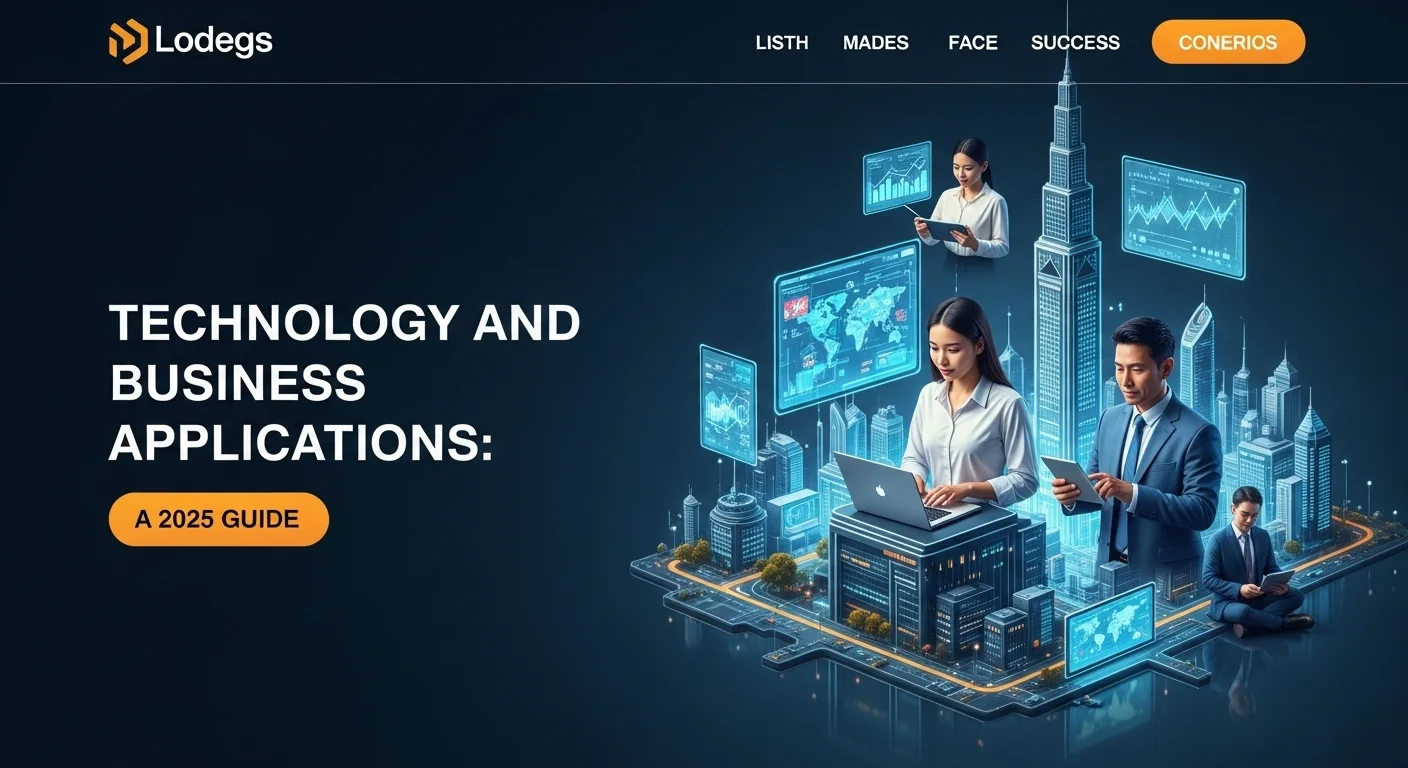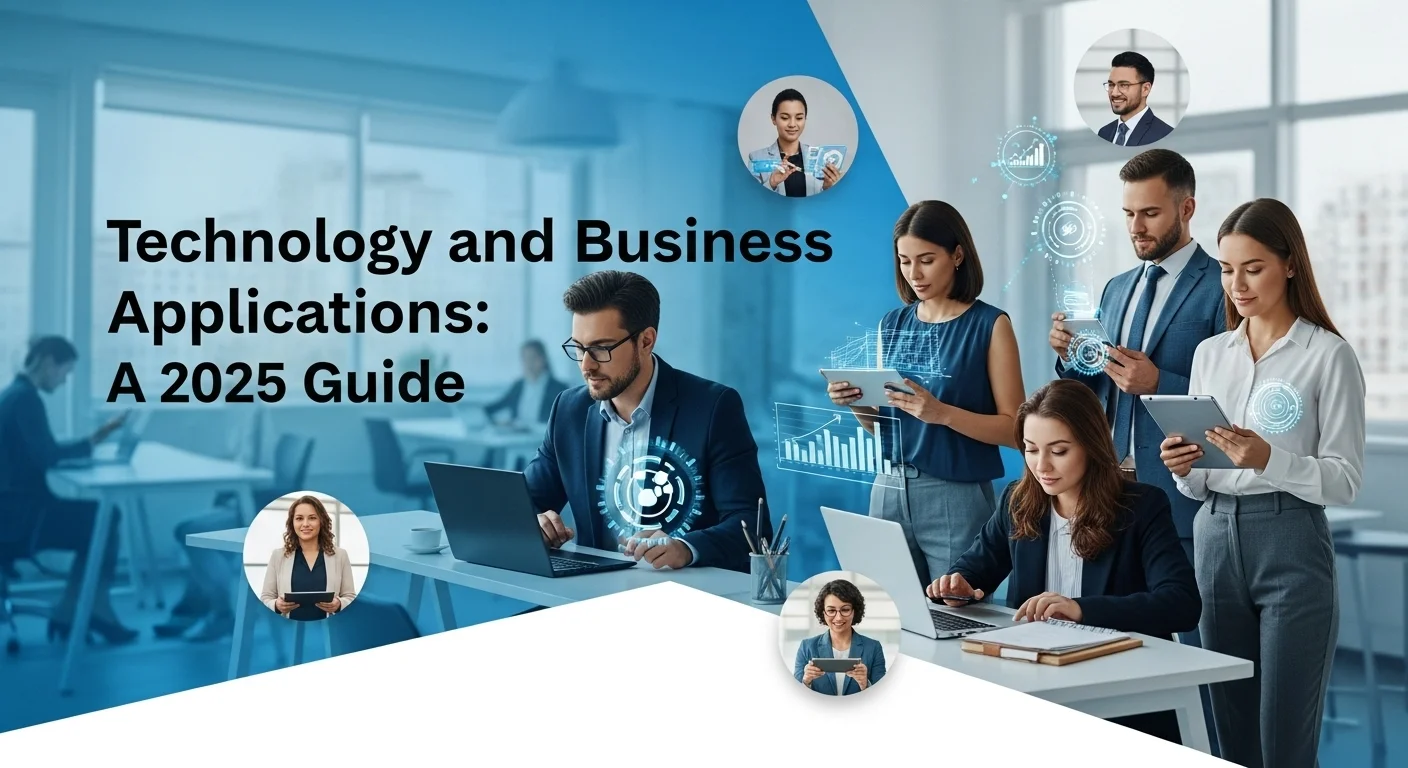How Business Apps Are Changing the Game: Your 2025 Guide to AI, ML, and ChatGPT

Executive Summary
Ever feel like you're drowning in data but starving for wisdom? That's where modern business applications come in. They are the engines that power today's most successful companies. In this guide, I'm going to pull back the curtain on how these essential tools work, from foundational systems like ERPs to the truly game-changing platforms driven by AI. We'll explore how technology is no longer just about being more efficient; it's about making smarter decisions, creating amazing customer experiences, and staying ahead of the curve. I'll share my experience with the incredible impact of artificial intelligence, especially machine learning (ML) and generative AI like ChatGPT. You'll see real-world examples of how these tools are transforming industries from the ground up. Think of this as your personal roadmap to understanding and using the full power of business applications in a world where tech leads the way.
Table of Contents
Table of Contents
What are Business Applications and why are they important in Technology?
In my years working in tech, I've seen the term 'Business Application' thrown around a lot. So, let's break it down simply. A business application is any piece of software that helps a company get its work done. Think of them as your digital workforce. This can be a massive, company-wide system like an Enterprise Resource Planning (ERP) platform that manages everything from finance to supply chains, or a simple, focused tool for project management. The whole point is to make operations smoother, boost efficiency, and help people make better, data-backed decisions. Their real importance comes from being the bridge between a company's big ideas and getting things done day-to-day. Honestly, without them, running a modern business would be nearly impossible.
From Mainframes to the Cloud: The Evolution of Business Apps
The journey of these applications is a story of technology's rapid progress. I remember when these were clunky, standalone systems on giant mainframe computers that only a handful of specialists could touch. Then, personal computers and the internet opened the doors, but the real revolution was cloud computing. The Software-as-a-Service (SaaS) model completely changed the game. Suddenly, businesses could access powerful tools without owning massive servers, offering flexibility I could only have dreamed of a decade ago. Now, we're in the age of intelligent apps. Technologies like Artificial Intelligence (AI) and Machine Learning (ML) aren't just cool features; they're at the very core of these systems. They can learn from data, automate complex tasks, and offer insights that predict what's next, making businesses faster and smarter. The use of ML in business has exploded. It's no longer theoretical; it's creating real value every day. For instance, the recommendation engine that suggests your next purchase on Amazon? That's an ML application. The system that flags a potentially fraudulent charge on your credit card? Also ML. These tools spot patterns a human could never see, driving efficiency and cutting risk.
The AI Revolution: How ML and ChatGPT Changed Everything
The conversation got even more exciting with the arrival of generative AI. Models like GPT-3 showed us the incredible potential of AI that could understand and create human-like text, opening a new world of possibilities for business applications. We started seeing it used for everything from writing marketing copy to summarizing long reports. With newer models like GPT-4, this trend has only accelerated. The practical applications for ChatGPT in business are growing by the day, and they're solving real problems. I've seen companies build ChatGPT-powered chatbots into their websites that provide amazing, human-like customer support 24/7. The results are undeniable: lower costs, happier customers, and the ability to handle more queries without hiring more people. The impact is huge, touching every industry you can think of. Beyond customer service, ChatGPT business applications are making a difference internally. Marketing teams use them to brainstorm ideas and write personalized emails. Developers I know use them to write and fix code, speeding up their workflow immensely. HR departments are even using them to draft job descriptions. This highlights a massive shift: business apps are no longer just passive tools. They are active partners, augmenting our own skills and automating tasks we once thought only humans could do. As tech keeps moving forward, having a smart application strategy is no longer just an advantage—it's essential for survival.

Your Complete Guide to Business Applications and Tech Solutions
Understanding the landscape of business applications means looking under the hood at the technology and strategies that make them work. It's not just about what the software does, but how it's built and chosen. Here's a guide to help you navigate the technical methods and strategic choices you'll face.
The Nuts and Bolts: How Modern Apps Are Built
The architecture is the blueprint of any application. For years, everything was 'monolithic'—built as one single, massive unit. It was simple at first, but a nightmare to update or scale. I've seen projects get bogged down for months trying to change one small feature in a monolithic app. To fix this, the industry moved to a 'microservices' architecture. Imagine building with LEGOs instead of a single block of marble. Each LEGO piece is a small, independent service that handles one specific job. You can update, fix, or scale one piece without touching the rest. It gives you incredible agility and resilience. A newer step is 'serverless computing.' This sounds technical, but the idea is simple: you just write the code for a function, and the cloud provider (like Amazon or Google) handles all the server stuff for you. It's efficient and can save a lot of money. The best choice often depends on your needs, and many businesses I work with use a mix of these approaches.
How these apps are developed is also key. Methodologies like Agile and DevOps are standard now. Agile focuses on building and releasing software in small, iterative cycles, constantly gathering feedback. DevOps takes it further by uniting the development and operations teams, creating a culture of shared responsibility. This combination, powered by automation, lets businesses release new features incredibly fast and reliably.
Unlocking Potential with AI and Machine Learning
The real magic in modern business solutions happens when you integrate AI. The applications of ML in business are transforming strategy. From a technical standpoint, integrating ML starts with data. You gather data, clean it up, and then 'train' a model to find patterns. Once it's ready, you connect this model to your business application through an API. For example, your customer relationship management (CRM) tool can send data to an ML model, which then predicts which customers are likely to leave. This allows you to step in before it's too late. This data-first approach is changing everything.
Generative AI, like ChatGPT, takes this to another level. A few years ago, using GPT-3 for business applications was cutting-edge. Today, integrating ChatGPT into your own apps is surprisingly straightforward thanks to powerful APIs. I've helped companies build internal knowledge bases where employees can just ask questions in plain English instead of digging through old documents. E-commerce sites can build shopping assistants that feel like you're talking to a real expert. These ChatGPT business applications aren't just about automation; they're about creating smart, interactive experiences that people love to use.
The Big Decision: Build a Custom App vs. Buy Off-the-Shelf
This is a question I get all the time: should we build our own software or buy something off the shelf? Buying a solution, usually as a SaaS subscription (think Salesforce or Shopify), gets you up and running quickly with lower initial costs. It’s a great option for standard business needs where a pre-made tool works just fine. However, it might not be flexible enough for your unique processes.
Building a custom application gives you total control and flexibility, creating a tool perfectly tailored to your business that can become a real competitive advantage. But it's a major investment of time and money. The decision often comes down to how critical the application is. For your 'secret sauce' processes, building might be worth it. For everything else, buying is usually smarter.
Many businesses now take a hybrid approach: they buy a core platform and then build custom integrations on top of it. This gives you the best of both worlds. When you're looking at any solution, a key question I always ask is, 'How well can this integrate with new tech?' For instance, can this CRM work with ChatGPT to improve our customer emails? Choosing the right path ensures your applications are scalable, secure, and ready for whatever comes next. Cloud platforms like AWS, Azure, and Google Cloud provide all the tools you need to support either strategy.

Tips and Strategies to Get the Most from Your Business Applications
Just having the right applications isn't enough. To truly benefit, you need a smart approach focusing on security, user happiness, and future-proofing your tech. Here are some actionable strategies I've learned over the years to help you maximize the value of your technology.
Rule #1: Don't Treat Security as an Afterthought
Take it from me, a data breach is a nightmare you don't want. Security needs to be baked into your applications from day one. Start with secure coding practices to prevent common vulnerabilities. It sounds technical, but it’s about simple habits that stop attacks before they happen. Always use strong authentication like multi-factor authentication (MFA) and enforce the 'principle of least privilege,' meaning people can only access what they absolutely need for their job. Protect your data like it's gold. That means encrypting sensitive information, both when it's moving across the internet and when it's stored in your database. You should also conduct regular security audits and penetration tests to find weak spots. Finally, make sure you're compliant with regulations like GDPR or HIPAA. A strong, proactive security plan isn't just about defense; it's about building trust with your customers.
Focus on the Human Element: User Experience and Change Management
Here’s a hard truth: the most brilliant app is worthless if your team hates using it. A great User Experience (UX) is essential for adoption. Invest in making your application's interface clean, intuitive, and logical. It should make your team's life easier, not harder. Just as important is change management. When you introduce a new tool, you need to explain the 'why'—how it will benefit everyone. Provide excellent training and easy-to-find support. I've seen companies use innovative ChatGPT applications to create interactive training bots that guide users through the new software. By focusing on the human side of technology, you ensure a smooth rollout and a much better return on your investment.
Build for Tomorrow: Integration and Future-Proofing
No application is an island. A modern business runs on a suite of connected tools. When choosing an app, prioritize those with strong APIs that allow for easy integration with your other systems. A connected ecosystem—where your sales, marketing, and finance software all talk to each other—eliminates errors, saves time, and gives you a clear picture of your business. Always think about the future. Choose scalable architectures and cloud platforms that can grow with you. And keep an eye on what's next in tech. A few years ago, exploring GPT-3 business applications was a smart move. Today, planning for how you'll use even more advanced ChatGPT business applications is a necessity. This forward-thinking approach to your tech stack is what will keep you agile and competitive. If you really want to go deep on this, the folks at BCG have an excellent breakdown on Generative AI's impact that I highly recommend. This kind of strategic foresight is what separates the good from the great.
Expert Reviews & Testimonials
Sarah Johnson, Business Owner ⭐⭐⭐
The information about Business Applications is correct but I think they could add more practical examples for business owners like us.
Mike Chen, IT Consultant ⭐⭐⭐⭐
Useful article about Business Applications. It helped me better understand the topic, although some concepts could be explained more simply.
Emma Davis, Tech Expert ⭐⭐⭐⭐⭐
Excellent article! Very comprehensive on Business Applications. It helped me a lot for my specialization and I understood everything perfectly.



